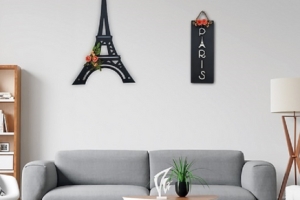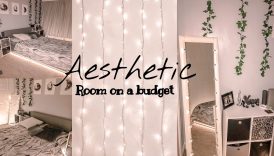The Psychology of Wall Art Decor: How Art Can Influence Your Mood

Art is more than just visual pleasure; it has a profound effect on our mood and overall well-being. Many people overlook the intrinsic connection between art and emotion, often considering it merely a decorative element in their lives. Yet, art holds the power to uplift spirits, provoke thought, and evoke memories. As someone who has greatly enjoyed transforming my home with various art pieces, I can personally attest to the positive shifts in my mood when surrounded by meaningful artwork. Whether it’s that vibrant abstract painting or a serene landscape, each piece contributes to the energy in the room, creating a unique ambiance. In this exploration, we will delve into how colors, styles, and placement of art can influence our emotions. We’ll also discuss the significance of personal connections to artwork and how cultural contexts shape our experiences. By the end, you’ll see art not just as an aesthetic choice but as a crucial component of nurturing a joyful and balanced life.
- The Psychology of Wall Art Decor: How Art Can Influence Your Mood
- The Impact of Colors on Mood
- Warm vs. Cool Colors
- Psychological Effects of Different Colors
- Art Styles and Mood Enhancement
- Abstract Art
- Realistic Art
- Personal Connection with Art
- Emotional Responses to Artwork
- Memories Associated with Art
- Art Placement and Mood
- Location of Wall Art
- Size and Proportion of Artwork
- Mindfulness and Art Appreciation
- Using Art for Relaxation
- Art as a Form of Meditation
- The Power of Nature in Art
- Biophilic Design in Wall Art
- Benefits of Nature-Inspired Art
- Cultural Influences on Art and Mood
- Cultural Symbolism in Art
- Traditional vs. Contemporary Art
- Customizing Art for Personal Well-being
- Creating DIY Artwork
- Commissioning Personalized Art Pieces
The Impact of Colors on Mood
Warm vs. Cool Colors
Colors play a vital role in how we perceive our surroundings and can significantly influence our emotions. Warm colors, such as reds, oranges, and yellows, tend to evoke feelings of excitement and energy. For instance, when I painted my living room a sunny yellow, the space instantly felt more inviting and cheerful. On the flip side, cool colors like blues, greens, and purples promote calmness and relaxation. After switching to a soft blue for my bedroom walls, I noticed a marked improvement in my sleep quality.
- Warm Colors: Energizing, passionate, and attention-grabbing.
- Cool Colors: Soothing, tranquil, and ideal for relaxation.
Psychological Effects of Different Colors
Beyond warm and cool, each color has its unique psychological effects. For example, red can stimulate the appetite and increase heart rates, making it popular in dining areas. Blue, known for its calming properties, is frequently found in spaces meant for relaxation. Consider these common associations:
- Yellow: Happiness and optimism
- Green: Nature, growth, and renewal
- Purple: Creativity and luxury
Understanding these effects can help you create spaces that resonate with your desired mood, enhancing your overall well-being.
Art Styles and Mood Enhancement
Abstract Art
Transitioning from the impact of colors, the style of artwork can significantly influence how it affects mood. Abstract art, with its bold forms and vibrant colors, invites viewers into a world of interpretation and emotion. Each brushstroke tells a unique story, often eliciting feelings of curiosity and wonder. For instance, I recently visited an abstract art exhibit that left me feeling invigorated and inspired.
- Emotional Freedom: Abstract art encourages personal interpretation, allowing individuals to connect with their own feelings.
- Energy and Movement: The dynamic compositions can create a lively atmosphere, perfect for spaces where creativity thrives.
Realistic Art
On the other hand, realistic art captures the world in all its detail, often evoking nostalgia and comforting memories. A beautifully painted landscape can transport you back to a cherished vacation, providing a sense of peace.
- Connection to Reality: Realistic art often grounds us, connecting us with familiar experiences.
- Detailed Imagery: The meticulous attention in realistic paintings can elicit admiration and inspire tranquility.
By choosing art styles that resonate with your emotional landscape, you can create spaces that nurture and uplift your mood.
Personal Connection with Art
Emotional Responses to Artwork
Building on the idea of art styles, the emotional responses we have to artwork can be deeply personal and profound. Art has a unique way of resonating within us, often stirring emotions we didn’t know were there. I remember standing before a painting that depicted a stormy sea, feeling a rush of adrenaline and a sense of connection to nature’s wildness.
- Joy: Bright colors and uplifting themes can spark feelings of happiness.
- Sadness: Darker themes in art might evoke nostalgia or reflection.
- Inspiration: Abstract pieces can inspire creativity and new ideas.
Memories Associated with Art
Art often holds memories, serving as visual reminders of times and places we’ve loved. For example, a quaint landscape painting in my grandmother’s living room always reminds me of the summers I spent at her house.
- Nostalgia: Certain artworks can transport us to cherished moments in time.
- Connection to People: Artwork given as gifts can enhance the emotional significance, connecting us to loved ones.
By recognizing these emotional responses and memories, we can choose art that not only beautifies our spaces but also enriches our lives in meaningful ways.
Art Placement and Mood
Location of Wall Art
Having explored personal connections to art, the placement of artwork in our spaces can significantly influence the mood and energy of a room. The right location can draw attention and enhance ambiance, while a poorly chosen spot may go unnoticed. In my own home, I’ve found that hanging a vibrant painting directly across from a seating area invites conversation and admiration from guests. Consider these tips for optimal art placement:
- Eye Level: Aim to hang art at eye level for the best viewing experience.
- Focal Points: Use art to create focal points in rooms, like above a mantel or a sofa, drawing the eye.
- Flow: Ensure that art complements the room’s layout and flow, enhancing overall harmony.
Size and Proportion of Artwork
The size and proportion of artwork play a crucial role in creating balance within a space. A large canvas can dominate a small room, while tiny pieces may get lost on expansive walls. I once made the mistake of hanging a small print in my dining room, which went unnoticed amidst broader décor.
- Balance: Aim for a mix of sizes for visual interest — small pieces can work well in galleries, while larger works can stand alone.
- Scale: Consider the scale of furniture to maintain harmony, ensuring the art feels integrated into the room.
By carefully considering both location and size, you can transform the atmosphere of your space, enhancing comfort and emotional connection to the artwork.
Mindfulness and Art Appreciation
Using Art for Relaxation
After examining art placement, it’s clear that engaging with art can also promote mindfulness and relaxation. For many, taking a moment to truly appreciate a piece of art can foster a sense of calm and centeredness. I remember visiting a local gallery where I found myself immersed in a serene landscape painting. As I focused on the soft hues and flowing lines, my mind quieted, and I felt my stress melting away. To incorporate art into your relaxation routine, consider these practices:
- Daily Viewing: Set aside time each day to simply observe a piece of art that resonates with you.
- Create a Calm Space: Designate a comfortable area in your home where you can sit quietly with art.
- Breathe Deeply: Use art as a cue for mindfulness, focusing on your breath as you observe the details.
Art as a Form of Meditation
Furthermore, art can serve as a powerful form of meditation. The act of creating or appreciating artwork can shift one’s mindset and promote a meditative state. During a recent painting workshop, I experienced this firsthand; lost in the colors and brushstrokes, I found a profound sense of presence and tranquility.
- Mindful Creation: Engage in art-making, focusing on the process rather than the outcome.
- Visual Meditation: Spend time visualizing art in detail, allowing your mind to wander through its textures and colors.
By intentionally using art in these ways, we can cultivate mindfulness, relaxation, and a deeper appreciation for the beauty surrounding us.
The Power of Nature in Art
Biophilic Design in Wall Art
Continuing on the journey of mindfulness and art appreciation, the integration of nature into our living spaces can profoundly enhance mood and well-being. Biophilic design emphasizes the connection between humans and nature, and it’s gaining popularity in wall art. I recently decorated my home office with prints of lush forests and tranquil water scenes, and immediately, those pieces transformed the room into an inspiring escape. To incorporate biophilic design effectively:
- Natural Imagery: Choose artwork that features landscapes, plants, or wildlife.
- Organic Materials: Consider using natural materials like wood or stone as part of your artwork or frames.
- Color Palette: Opt for earthy tones and soothing colors drawn from nature.
Benefits of Nature-Inspired Art
Nature-inspired art offers numerous benefits, extending beyond aesthetics. Research shows that exposure to nature, even through art, can reduce stress and promote happiness.
- Improved Focus: Nature scenes can help enhance concentration and creativity.
- Emotional Well-Being: Natural imagery often induces feelings of calm and relaxation, integrating beautifully into spaces meant for rest and rejuvenation.
- Connection to Outdoors: Incorporating art that evokes nature allows us to connect with the great outdoors, particularly in urban settings where natural elements may be scarce.
By celebrating the beauty of nature through art, we can create environments that nurture our mental and emotional health.
Cultural Influences on Art and Mood
Cultural Symbolism in Art
Shifting our focus from the power of nature in art, we can see how cultural influences shape our emotional responses to artwork. Cultural symbolism plays a vital role in how we interpret and connect with art pieces. For instance, during a recent art fair, I came across a stunning piece that featured intricate patterns reminiscent of African textiles. The vibrant colors and symbols not only captivated me but also evoked a sense of heritage and storytelling.
- Cultural Context: Understanding the cultural background of an artwork can deepen emotional resonance.
- Symbolic Meanings: Different colors and patterns often carry significant meanings, such as peace, prosperity, or even protection.
- Shared Experiences: Art that reflects shared cultural experiences can forge stronger emotional connections.
Traditional vs. Contemporary Art
Additionally, the contrast between traditional and contemporary art also influences mood and appreciation. Traditional art often showcases time-honored techniques and themes, invoking feelings of nostalgia and respect. For example, I find classical portraits remind me of history and give a sense of connection to the past.
- Traditional Art: Typically features realism, historical themes, and meticulous detail.
- Contemporary Art: Embraces innovation and experimentation, often provoking thought and challenging norms.
Both styles offer unique emotional landscapes, allowing individuals to find art that resonates with their experiences and feelings. By understanding cultural influences, we can enrich our appreciation and choice of art, ultimately enhancing our emotional environments.
Customizing Art for Personal Well-being
Creating DIY Artwork
As we delve into customizing art for personal well-being, one exciting avenue is creating DIY artwork. Engaging in the creative process not only results in unique pieces that reflect your personality but also serves as a relaxing and therapeutic activity. I remember spending an afternoon painting a large canvas with vibrant colors representing my favorite seasons. The outcome was not only visually appealing but also became a cherished reminder of that joyful experience. To start your DIY journey, consider these tips:
- Use Recycled Materials: Transform old magazines, fabrics, or canvas into beautiful art.
- Experiment with Techniques: Try different methods like splatter painting or collage to discover your style.
- Make It Personal: Incorporate meaningful quotes or images that resonate with you.
Commissioning Personalized Art Pieces
Another fantastic option is commissioning personalized art pieces from local artists. This not only allows you to tailor artwork to fit your style and preferences but also supports the artistic community. I once commissioned a portrait of my family, and it now hangs proudly in our living room, sparking countless conversations and offering warm memories.
- Collaboration: Work closely with the artist to convey your vision and ideas.
- Unique Expressions: Commissioned art often reflects personal stories, making it deeply meaningful.
- Investing in Local Talent: Supporting local artists contributes to your community’s culture and creativity.
By customizing art, whether through creating or commissioning, you nurture your environment and enhance personal well-being, allowing art to serve as a true reflection of your life and experiences.




